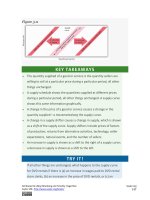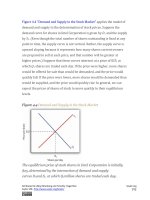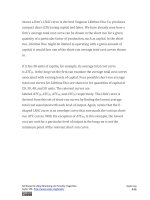Authors libby rittenberg 158
Bạn đang xem bản rút gọn của tài liệu. Xem và tải ngay bản đầy đủ của tài liệu tại đây (415.25 KB, 1 trang )
equilibrium quantity is 25 million pounds of coffee per month.Figure
3.17 "Changes in Demand and Supply" shows what happens with an
increase in demand, a reduction in demand, an increase in supply, and a
reduction in supply. We then look at what happens if both curves shift
simultaneously. Each of these possibilities is discussed in turn below.
An Increase in Demand
An increase in demand for coffee shifts the demand curve to the right, as
shown in Panel (a) ofFigure 3.17 "Changes in Demand and Supply". The
equilibrium price rises to $7 per pound. As the price rises to the new
equilibrium level, the quantity supplied increases to 30 million pounds of
coffee per month. Notice that the supply curve does not shift; rather, there
is a movement along the supply curve.
Demand shifters that could cause an increase in demand include a shift in
preferences that leads to greater coffee consumption; a lower price for a
complement to coffee, such as doughnuts; a higher price for a substitute
for coffee, such as tea; an increase in income; and an increase in
population. A change in buyer expectations, perhaps due to predictions of
bad weather lowering expected yields on coffee plants and increasing
future coffee prices, could also increase current demand.
A Decrease in Demand
Panel (b) of Figure 3.17 "Changes in Demand and Supply" shows that a
decrease in demand shifts the demand curve to the left. The equilibrium
price falls to $5 per pound. As the price falls to the new equilibrium level,
the quantity supplied decreases to 20 million pounds of coffee per month.
Attributed to Libby Rittenberg and Timothy Tregarthen
Saylor URL: />
Saylor.org
158









